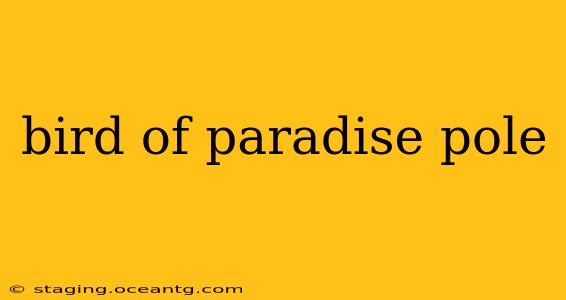The bird of paradise pole, a captivating and elegant piece of equipment, is more than just a prop; it's a crucial tool for dancers seeking to express grace, strength, and artistry. This article delves into the world of bird of paradise poles, exploring their unique features, uses, and the artistry they facilitate. We'll also address some frequently asked questions surrounding this beautiful and versatile dance tool.
What is a Bird of Paradise Pole?
A bird of paradise pole is a long, slender pole, typically made of lightweight yet durable materials like fiberglass or carbon fiber. Its defining characteristic is its elegant, often curved or flowing design, reminiscent of the graceful plumage of the bird of paradise. Unlike standard poles used in pole dancing, the bird of paradise pole is designed for a different aesthetic and style of movement. It's used to create flowing, lyrical movements, often incorporating elements of flexibility, contortion, and aerial work.
What are the Benefits of Using a Bird of Paradise Pole?
The bird of paradise pole offers several advantages for dancers:
- Enhanced Flexibility and Strength: The flowing movements required often lead to improvements in flexibility, core strength, and overall body conditioning.
- Expressive Artistic Movement: The pole allows for a more expressive and fluid style of dance, emphasizing grace and artistry over strength-based tricks.
- Unique Choreographic Possibilities: The design opens doors for unique choreography, allowing dancers to explore new movements and styles that differ from traditional pole dancing.
- Increased Confidence: Mastering the movements on the bird of paradise pole can significantly boost a dancer's confidence and body awareness.
What Types of Dance Use Bird of Paradise Poles?
Bird of paradise poles are frequently used in various dance styles, including:
- Lyrical Pole Dance: This style blends the fluidity of lyrical dance with the strength and grace of pole dancing.
- Contemporary Dance: The pole can be integrated into contemporary routines to add unique visual elements and challenges.
- Aerial Arts: Some aerial artists utilize modified bird of paradise poles to create stunning aerial sequences.
How Do I Choose a Bird of Paradise Pole?
Selecting the right bird of paradise pole depends on several factors:
- Material: Fiberglass and carbon fiber are common choices; fiberglass is generally more affordable, while carbon fiber is lighter and stronger.
- Length and Design: Consider the dancer's height and the style of dance they will be performing. Some poles are more dramatically curved than others.
- Weight: A lighter pole will allow for more dynamic and fluid movements.
Where Can I Buy a Bird of Paradise Pole?
Several online retailers and dance supply stores specialize in selling bird of paradise poles. Researching different suppliers will help you find the best pole to suit your needs and budget.
How Much Does a Bird of Paradise Pole Cost?
The price of a bird of paradise pole can vary depending on the materials, length, and design. Expect to pay a higher price for poles made from carbon fiber or featuring intricate designs.
What is the Difference Between a Bird of Paradise Pole and a Regular Pole Dancing Pole?
The key difference lies in the design and intended use. A regular pole dancing pole is typically straight and designed for strength-based tricks and spins. A bird of paradise pole, with its curved design, prioritizes graceful, flowing movements and a different aesthetic.
Is it Difficult to Learn to Use a Bird of Paradise Pole?
Like any dance form, mastering the bird of paradise pole takes time and practice. Beginners should start with basic movements and gradually progress to more advanced techniques. Professional instruction is highly recommended.
This exploration of the bird of paradise pole aims to provide a comprehensive understanding of this unique dance tool. While its aesthetic beauty is undeniable, its versatility and capacity to enhance both physical capabilities and artistic expression make it an invaluable asset for dancers seeking to expand their creative horizons. Remember, safe practice and professional guidance are crucial for mastering this elegant art form.
